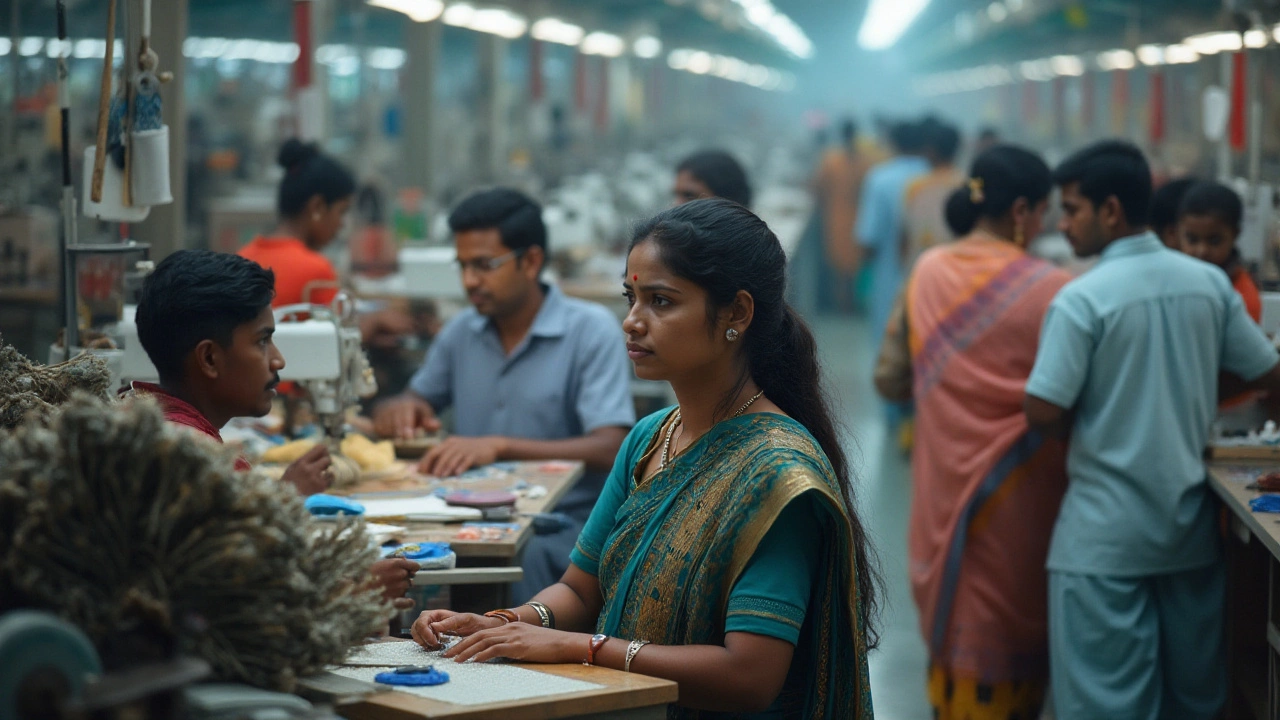In many communities, the resurgence of local manufacturing is more than just a trend—it's a strategic move with far-reaching economic implications. This shift towards localized production is not just about economics; it's about building stronger, more resilient communities that can withstand external shocks.
By centering production within a country, we tap into a deeper well of potential, fostering not only job creation but also a skilled workforce that is fit for the challenges of a rapidly changing market. Local manufacturing can significantly cut down on import dependency, simplifying supply chains and reducing risks associated with global uncertainties.
Additionally, when governments support this sector through tailored schemes, they inadvertently spark innovation and technological advances. These improvements, in turn, have a multiplier effect, enhancing various sectors of the economy. Moreover, utilizing local resources means less strain on environmental ecosystems, making local manufacturing a sustainable choice for future growth.
- Job Creation and Workforce Empowerment
- Reducing Import Dependency
- Innovation and Technology Advancements
- Government Schemes and Support
- Sustainability and Local Resources
Job Creation and Workforce Empowerment
Local manufacturing serves as a key driver for generating employment within a community. By investing in local manufacturing infrastructures, regions can tap into vast pools of untapped talent and labor. When production facilities set up operations, they require a diverse array of skills ranging from assembly line technicians to engineers and administrative staff. This means more opportunities for individuals who might have otherwise faced limited job prospects, translating into lowered unemployment rates and a push towards economic stability. According to the International Labour Organization (ILO), regions that prioritize manufacturing typically see a 20% increase in employment over a span of five years, indicating a clear link between production and job creation.
The creation of jobs, however, is only part of the equation. Empowering the workforce involves equipping individuals with the necessary skills and training to excel in their roles. Government schemes often play a pivotal role in this regard. Vocational training programs and partnerships with educational institutions are designed to enhance skill levels. These initiatives not only improve productivity but also ensure that workers can adapt to technological changes and industry shifts. In a global survey conducted by McKinsey, 62% of manufacturing firms reported that workforce skill enhancement directly improved their operational efficiency.
The renowned economist John Komlos once noted, "Investing in local skills and manufacturing doesn’t just fill jobs; it builds careers and transforms futures."The ripple effect of manufacturing extends beyond individual employment. When local communities thrive, secondary sectors flourish as well. Restaurants, housing, retail, and service sectors see an uptick as they cater to the needs of the burgeoning workforce. This creates a cycle of prosperity with benefits radiating outward. A study from the Economic Policy Institute highlights that for every manufacturing job created, an additional 1.6 jobs are supported indirectly in other parts of the economy. Such statistics underscore the transformational impact of promoting local manufacturing from a job creation standpoint.
Reducing Import Dependency
Local manufacturing offers a robust pathway to decrease a nation's reliance on imports. When a country strengthens its internal production capabilities, it gains a critical advantage in economic stability. By producing goods domestically, a nation doesn't have to depend heavily on international markets, which can be unpredictable and often subject to geopolitical tensions. This self-sufficiency can lead to more stable prices for consumers and a more resilient economy capable of withstanding external shocks.
The benefits of reducing import dependency extend beyond just economic stability. It also means that domestic industries can focus on refining their processes and products without external pressures. This fosters an environment of innovation and growth. Local manufacturers can tailor their products to meet the specific demands and preferences of local markets, something foreign manufacturers may struggle to do efficiently. This localized approach helps ensure that products are not only cost-effective but also culturally and environmentally appropriate.
According to a report by the World Bank, "countries investing in local manufacturing have seen up to a 25% reduction in import costs over the last decade." This creates a positive ripple effect throughout the economy, where funds that would have been used for imports can now be redirected towards other essential areas like education and infrastructure. This shift not only leads to economic growth but also improves the overall quality of living for citizens. With local manufacturers growing, job creation becomes a natural outcome, providing more opportunities for the workforce.
On top of that, reducing import dependency contributes to a decreased carbon footprint. Transporting goods across oceans and borders significantly adds to the environmental cost. Local manufacturing reduces this dependency on long supply chains and the associated carbon emissions. As environmental awareness becomes increasingly important, a move towards local production aligns with global sustainability goals, making it a win-win strategy. A country that invests in its local manufacturing capability can craft a path toward sustainable economic growth and long-term resilience.

Innovation and Technology Advancements
Local manufacturing doesn't just promote economic resilience; it acts as a catalyst for innovation and technological advancements across industries. When manufacturing activities are drawn closer to home, it invariably leads to a surge in research and development efforts aimed at optimizing efficiency and quality. This process is both organic and strategic, as companies strive to stay competitive within a localized context, paving the way for technological breakthroughs. For instance, the push for smart factories and Industry 4.0 technologies has gained momentum thanks to local manufacturing initiatives. By integrating IoT, AI, and machine learning, manufacturers are not only enhancing product efficiency but also reinventing how we perceive traditional manufacturing processes.
The proximity of manufacturing operations to technology centers and research institutions facilitates unprecedented collaboration between industry and academia. This symbiotic relationship accelerates the pace of innovation, as fresh ideas from academia can be rapidly prototyped and refined in real-world manufacturing environments. Take, for example, the case of Germany, where robust local manufacturing has led to a distinct edge in automotive technologies thanks to direct collaboration between universities and car manufacturers.
“Innovation distinguishes between a leader and a follower,” said Steve Jobs, reflecting how embracing new technologies can propel industries to leadership positions.These advancements are not limited to the introduction of high-end technologies; they extend to process innovation as well, allowing manufacturing to become more sustainable and resource-efficient.
Moreover, local manufacturing presents an opportunity for technology transfer, both within the nation and across borders, as companies seek new markets for their innovations. This exchange of knowledge and technology fuels a cycle of creativity and problem-solving, wherein local enterprises learn from global best practices and adapt them to suit regional needs. According to a study by the National Institute of Standards and Technology (NIST), companies that localized production witnessed a 40% increase in the speed of adopting new technologies. There's an allure in the ability of local manufacturers to pivot quickly in response to technological innovations, a flexibility often absent in larger, less agile global supply chains. The enhanced rate of adoption ultimately feeds back into the business ecosystem, inspiring more startups and initiatives centered around advanced manufacturing technology.
Furthermore, the government has recognized the pivotal role of local manufacturing in spawning technological growth and has thus funneled resources into supporting innovation hubs and granting R&D tax credits. These incentives encourage business owners to invest more confidently in technological upgrades and process overhauls. In many cases, these advancements have been crucial in reducing production costs and boosting productivity, creating a compelling case for local manufacturing as a driver of technological change. As more industries seize the opportunity to innovate through local manufacturing, the economic landscape becomes not only technologically advanced but also more self-reliant.
Government Schemes and Support
The proliferation of local manufacturing in recent years has been significantly aided by various government schemes and support mechanisms that aim to prop up this vital sector. Governments around the globe recognize the intrinsic value of localized production and have thus, crafted policies to energize industries, create jobs, and foster a skilled workforce. These policies have a multi-layered impact as they often come with financial incentives, tax relaxations, and infrastructural support. For example, India's 'Make in India' initiative stands as a monumental effort, encouraging not only international but also domestic companies to produce within the nation's borders.
Such initiatives don't operate in a vacuum. In the United States, similar mechanisms have been seen with the Manufacturing USA program which offers funding, resources, and expertise to boost innovation in the manufacturing industry. These programs ensure that manufacturers have access to essential infrastructure, including technology hubs and research facilities, enhancing their competitive edge. The funding often covers research and development efforts, understanding that innovation cannot thrive without substantial initial investment.
"The path to economic resilience lies in strong local supply chains supported by targeted government initiatives," says an expert from the World Economic Forum.
To propel the sector forward, educational programs are typically embedded within these schemes, bridging the gap between industry demands and workforce capabilities. Skill development centers equipped with state-of-the-art technology train individuals to excel in modern production processes. In countries such as Germany, the dual apprenticeship system has gained plaudits for seamlessly integrating vocational training with practical experience in companies, thereby meeting the specific requirements of the manufacturing sector. This model serves as an aspirational benchmark for others aiming to upskill their workforce.
Embracing local manufacturing and employing government support can have a major ripple effect. It often results in the flourishing of associated businesses, such as logistics and supply chain services, thereby creating an ecosystem that thrives on cooperation and synergy. More often than not, this leads to the generation of new economic benefits as businesses share expertise, resources, and even workforce. Additionally, by promoting local production, governments can work towards a more sustainable economy, reducing carbon footprints associated with transporting goods across vast distances.
Data underscores the effectiveness of these initiatives. According to reports, localized manufacturing initiatives in European nations have resulted in substantive increases in employment, with some regions witnessing a 10% growth in manufacturing jobs over a span of five years. Such statistics not only highlight the necessity of government schemes but also underscore the importance of sustained support to continue reaping these economic benefits.

Sustainability and Local Resources
The conversation about local manufacturing often turns naturally to sustainability. One of its key advantages is the opportunity to leverage local resources, which can profoundly impact both the environment and the economy. By utilizing materials and energy sources that are readily available within a region, manufacturing plants can significantly reduce their carbon footprint. This contrasts starkly with the emissions incurred by transporting goods and raw materials across the globe, underscoring the environmental benefits of local sourcing.
Additionally, local manufacturing encourages more sustainable resource management practices. When production is concentrated locally, there is an increased awareness and accountability regarding how resources are extracted and used. Such scrutiny can lead to more innovative approaches to minimizing waste and increasing efficiency. It's not just about the resources themselves; the processes involved in their extraction and use also become more sustainable. This shift towards greener methodologies has the potential to transform not only the manufacturing sector but also the surrounding ecosystems.
"The localization of supply chains can result in significant energy savings across the sector," says Jennifer Harrington, a well-respected analyst with the Global Sustainable Development Coalition. "By keeping production close to home, we significantly cut down on the emissions related to the transportation of materials and finished goods."
Furthermore, local manufacturing often supports the development and employment of clean technology and renewable energy systems. This support is not just about installing solar panels on factory rooftops; it's about weaving sustainability into every level of production. Utilizing local resources also ties into a broader, more resilient economic narrative. It strengthens local economies by circulating wealth within the community, which helps build economic resilience. When local companies are less dependent on foreign supplies, they are better equipped to adapt to global changes, recessions, or disruptions.
Moreover, as communities witness the immediate benefits and potential of local manufacturing, there tends to be a shift in consumer behavior towards supporting locally made products. This shift helps foster a robust economic environment where industries are encouraged to innovate and advance. In many ways, local manufacturing paves the path for a more sustainable future, intertwining economic growth with environmental stewardship. While statutory support is essential, the profound changes needed are often driven by a well-informed stakeholder ecosystem.
Embracing Renewable Energy
Local manufacturing's alignment with sustainability goals also encompasses substantial incorporation of renewable energy resources. Factories and production sites are shifting towards harnessing the power of wind, solar, and biomass energies, drastically cutting their dependency on fossil fuels. This transition is expedited by advancements in technology, making renewable energy more accessible and cost-effective than ever before. Investing in these alternatives not only reduces the carbon emissions of manufacturing operations but also creates new jobs within the green energy sector.
